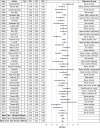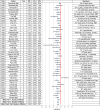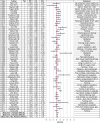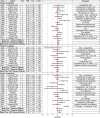Association between Parkinson's Disease and Cigarette Smoking, Rural Living, Well-Water Consumption, Farming and Pesticide Use: Systematic Review and Meta-Analysis
- PMID: 27055126
- PMCID: PMC4824443
- DOI: 10.1371/journal.pone.0151841
Association between Parkinson's Disease and Cigarette Smoking, Rural Living, Well-Water Consumption, Farming and Pesticide Use: Systematic Review and Meta-Analysis
Abstract
Objective: Bradford Hill's viewpoints were used to conduct a weight-of-the-evidence assessment of the association between Parkinson's disease (PD) and rural living, farming and pesticide use. The results were compared with an assessment based upon meta-analysis. For comparison, we also evaluated the association between PD and cigarette smoking as a "positive control" because a strong inverse association has been described consistently in the literature.
Methods: PubMed was searched systematically to identify all published epidemiological studies that evaluated associations between Parkinson's disease (PD) and cigarette smoking, rural living, well-water consumption, farming and the use of pesticides, herbicides, insecticides, fungicides or paraquat. Studies were categorized into two study quality groups (Tier 1 or Tier 2); data were abstracted and a forest plot of relative risks (RRs) was developed for each risk factor. In addition, when available, RRs were tabulated for more highly exposed individuals compared with the unexposed. Summary RRs for each risk factor were calculated by meta-analysis of Tier 1, Tier 2 and all studies combined, with sensitivity analyses stratified by other study characteristics. Indices of between-study heterogeneity and evidence of reporting bias were assessed. Bradford Hill's viewpoints were used to determine if a causal relationship between PD and each risk factor was supported by the weight of the evidence.
Findings: There was a consistent inverse (negative) association between current cigarette smoking and PD risk. In contrast, associations between PD and rural living, well-water consumption, farming and the use of pesticides, herbicides, insecticides, fungicides or paraquat were less consistent when assessed quantitatively or qualitatively.
Conclusion: The weight of the evidence and meta-analysis support the conclusion that there is a causal relationship between PD risk and cigarette smoking, or some unknown factor correlated with cigarette smoking. There may be risk factors associated with rural living, farming, pesticide use or well-water consumption that are causally related to PD, but the studies to date have not identified such factors. To overcome the limitations of research in this area, future studies will have to better characterize the onset of PD and its relationship to rural living, farming and exposure to pesticides.
Conflict of interest statement
Figures









References
-
- Parkinson J. An essay on the shaking palsy. J Neuropsychiatry Clin Neurosci. 2002;14(2):223–36. Epub 2002/05/02. . - PubMed
-
- Ascherio A, Weisskopf MG, O'Reilly EJ, McCullough ML, Calle EE, Rodriguez C, et al. Coffee consumption, gender, and Parkinson's disease mortality in the cancer prevention study II cohort: the modifying effects of estrogen. Am J Epidemiol. 2004;160(10):977–84. Epub 2004/11/04. 10.1093/aje/kwh312 . - DOI - PubMed
-
- Klein C. Genetics of Parkinson's disease—An overview In: Fahn S, Lang AE, Schapira AHV, editors. Movement Disorders 4 Philadelphia: Saunders/Elsevier; 2010. p. 15–39.
Publication types
MeSH terms
Substances
LinkOut - more resources
Full Text Sources
Other Literature Sources
Medical

